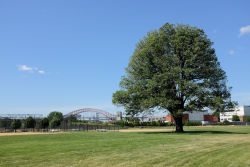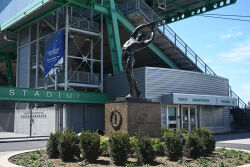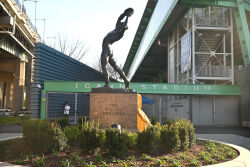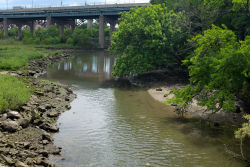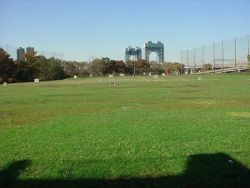Randall's Island Park
The Daily Plant : Thursday, July 14, 2011
Ground Is Broken On Randall's Island's Hell Gate Path
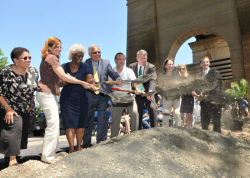
Photo by Daniel Avila
On July 1, Parks & Recreation Commissioner Adrian Benepe joined NYC Economic Development Corporation President Seth Pinsky, City Council Member Melissa Mark-Viverito, New York Secretary of State Cesar Perales, Deputy Bronx Borough President Aurelia Greene, Amtrak Vice President of Government Affairs & Corporate Communications Joe McHugh, Randall's Island Sports Foundation Co-Chair Nancy Neff, Randall's Island Sports Foundation Executive Director Aimee Boden, and children from the Casita Maria Center for Arts and Education to break ground on the Hell Gate Pathway at Randall's Island.
The Hell Gate Pathway will run under the scenic sand-colored arches of the Hell Gate Bridge and railroad trestle between the Hell Gate rapids to the south of Randall’s Island Park and the Bronx Kill to its north. A key part of an Island-wide pathway system, the Hell Gate Pathway will open over a mile of non-vehicular access along renovated and reclaimed parkland. It is an important link in creating a passable loop around most of the Park and joining points adjacent to all three surrounding boroughs of Queens, Manhattan and the Bronx. It will also run directly into the Bronx Connector, the first at-grade access to Randall’s Island from the Bronx, which is slated for construction in coming years.
The Hell Gate Pathway was developed by RISF in partnership with Parks and NYCEDC. It was designed by Starr Whitehouse Landscape Architects and Planners and funded through a federal DOT Transportation Enhancements Program (TEP) grant with a local match from the Manhattan Borough President. Construction was made possible by Environmental Protection Fund (EPF) grants from the New York State Department of State and the New York State Office of Parks, Recreation and Historic Preservation alongside funding from the Office of the Mayor Michael R. Bloomberg. EDC is managing the first phase of the pathway’s construction. Amtrak, which runs Northeast Corridor service along the Hell Gate trestle, partnered with RISF and Parks by contributing over $15 million toward securing the bridge to ensure safe passage under its arches.
The dramatic arcade structure of the Hell Gate Bridge and railroad trestle spans Randall’s Island Park approximately one hundred feet above the ground. This unique piece of City infrastructure has been the subject of both textual accolades and restoration efforts. Admired for the Classicism of its piers as well as for innovative elements such as the reverse curve in its top chord, the Bridge was determined eligible for the National Register of Historic Places in 1977, and its history reaches back to the early days of New York’s great bridges and railways.
The Hell Gate Bridge and trestle were designed by the renowned engineering team of Henry Hornbostel and Gustav Lindenthal, just a few years after their completion of the Queensboro Bridge. It is the longest bridge of its type in the world; built in 1917, its 1,017-foot parabolic arch and three miles of concrete viaduct run from Astoria, Queens across the entirety of the Park to the South Bronx. This passage was commissioned by railroad companies in 1912 to conquer the busy and treacherous shipping channel of “Hell Gate,” so named by New York’s earliest European explorers for its deadly tides and white water rips.
Hell Gate is where the East River and Harlem River meet to run toward the Atlantic Ocean, creating some of the most dangerous and turbulent waters to navigate along the East Coast. The Bridge that finally crossed these waters was built with the future in mind, to accommodate more and heavier trains than were currently in use. Such foresight paid off, and the Hell Gate Bridge still serves as an important connection in the rail system from Canada and New England to the South and West.
QUOTATION FOR THE DAY
“Dream, diversify – and never miss an angle.”
Walt Disney
(1901 – 1966)
Check out your park's Vital Signs
Clean & Safe
Green & Resilient
Empowered & Engaged Users
Share your feedback or learn more about how this park is part of a
Vital Park System

